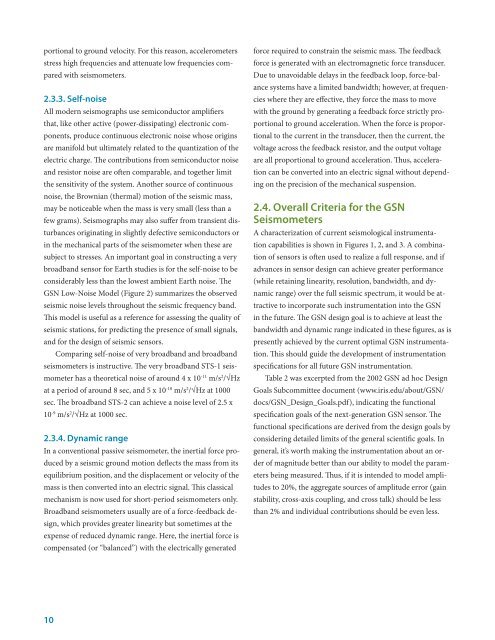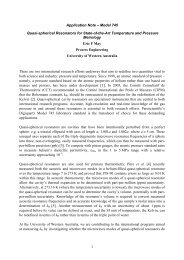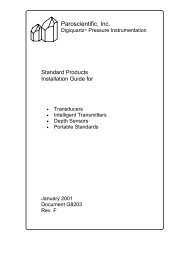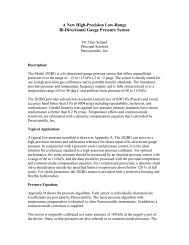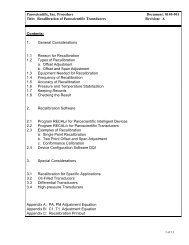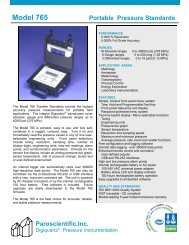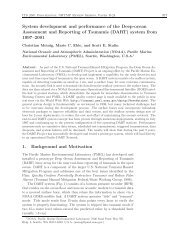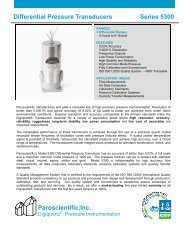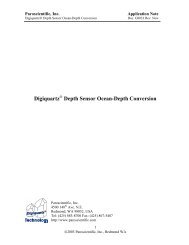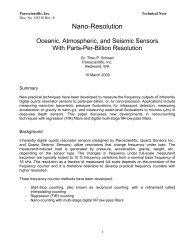FOR LOWïºFREQUENCY SEISMOMETRY - IRIS
FOR LOWïºFREQUENCY SEISMOMETRY - IRIS
FOR LOWïºFREQUENCY SEISMOMETRY - IRIS
- No tags were found...
You also want an ePaper? Increase the reach of your titles
YUMPU automatically turns print PDFs into web optimized ePapers that Google loves.
portional to ground velocity. For this reason, accelerometersstress high frequencies and attenuate low frequencies comparedwith seismometers.2.3.3. Self-noiseAll modern seismographs use semiconductor amplifiersthat, like other active (power-dissipating) electronic components,produce continuous electronic noise whose originsare manifold but ultimately related to the quantization of theelectric charge. The contributions from semiconductor noiseand resistor noise are often comparable, and together limitthe sensitivity of the system. Another source of continuousnoise, the Brownian (thermal) motion of the seismic mass,may be noticeable when the mass is very small (less than afew grams). Seismographs may also suffer from transient disturbancesoriginating in slightly defective semiconductors orin the mechanical parts of the seismometer when these aresubject to stresses. An important goal in constructing a verybroadband sensor for Earth studies is for the self-noise to beconsiderably less than the lowest ambient Earth noise. TheGSN Low-Noise Model (Figure 2) summarizes the observedseismic noise levels throughout the seismic frequency band.This model is useful as a reference for assessing the quality ofseismic stations, for predicting the presence of small signals,and for the design of seismic sensors.Comparing self-noise of very broadband and broadbandseismometers is instructive. The very broadband STS-1 seismometerhas a theoretical noise of around 4 x 10 -11 m/s 2 /√Hzat a period of around 8 sec, and 5 x 10 -10 m/s 2 /√Hz at 1000sec. The broadband STS-2 can achieve a noise level of 2.5 x10 -9 m/s 2 /√Hz at 1000 sec.2.3.4. Dynamic rangeIn a conventional passive seismometer, the inertial force producedby a seismic ground motion deflects the mass from itsequilibrium position, and the displacement or velocity of themass is then converted into an electric signal. This classicalmechanism is now used for short-period seismometers only.Broadband seismometers usually are of a force-feedback design,which provides greater linearity but sometimes at theexpense of reduced dynamic range. Here, the inertial force iscompensated (or “balanced”) with the electrically generatedforce required to constrain the seismic mass. The feedbackforce is generated with an electromagnetic force transducer.Due to unavoidable delays in the feedback loop, force-balancesystems have a limited bandwidth; however, at frequencieswhere they are effective, they force the mass to movewith the ground by generating a feedback force strictly proportionalto ground acceleration. When the force is proportionalto the current in the transducer, then the current, thevoltage across the feedback resistor, and the output voltageare all proportional to ground acceleration. Thus, accelerationcan be converted into an electric signal without dependingon the precision of the mechanical suspension.2.4. Overall Criteria for the GSNSeismometersA characterization of current seismological instrumentationcapabilities is shown in Figures 1, 2, and 3. A combinationof sensors is often used to realize a full response, and ifadvances in sensor design can achieve greater performance(while retaining linearity, resolution, bandwidth, and dynamicrange) over the full seismic spectrum, it would be attractiveto incorporate such instrumentation into the GSNin the future. The GSN design goal is to achieve at least thebandwidth and dynamic range indicated in these figures, as ispresently achieved by the current optimal GSN instrumentation.This should guide the development of instrumentationspecifications for all future GSN instrumentation.Table 2 was excerpted from the 2002 GSN ad hoc DesignGoals Subcommittee document (www.iris.edu/about/GSN/docs/GSN_Design_Goals.pdf), indicating the functionalspecification goals of the next-generation GSN sensor. Thefunctional specifications are derived from the design goals byconsidering detailed limits of the general scientific goals. Ingeneral, it’s worth making the instrumentation about an orderof magnitude better than our ability to model the parametersbeing measured. Thus, if it is intended to model amplitudesto 20%, the aggregate sources of amplitude error (gainstability, cross-axis coupling, and cross talk) should be lessthan 2% and individual contributions should be even less.10


